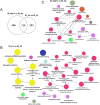Phospholipid production and signaling by a plant defense inducer against Podosphaera xanthii is genotype-dependent
- PMID: 39247879
- PMCID: PMC11377184
- DOI: 10.1093/hr/uhae190
Phospholipid production and signaling by a plant defense inducer against Podosphaera xanthii is genotype-dependent
Abstract
Biotrophic phytopathogenic fungi such as Podosphaera xanthii have evolved sophisticated mechanisms to adapt to various environments causing powdery mildews leading to substantial yield losses. Today, due to known adverse effects of pesticides, development of alternative control means is crucial and can be achieved by combining plant protection products with resistant genotypes. Using plant defense inducers, natural molecules that stimulate plant immune system mimicking pathogen attack is sustainable, but information about their mode of action in different hosts or host genotypes is extremely limited. Reynoutria sachalinensis extract, a known plant defense inducer, especially through the Salicylic acid pathway in Cucurbitaceae crops against P. xanthii, was employed to analyze the signaling cascade of defense activation. Here, we demonstrate that R. sachalinensis extract enhances phospholipid production and signaling in a Susceptible to P. xanthii courgette genotype, while limited response is observed in an Intermediate Resistance genotype due to genetic resistance. Functional enrichment and cluster analysis of the upregulated expressed genes revealed that inducer application promoted mainly lipid- and membrane-related pathways in the Susceptible genotype. On the contrary, the Intermediate Resistance genotype exhibited elevated broad spectrum defense pathways at control conditions, while inducer application did not promote any significant changes. This outcome was obvious and at the metabolite level. Main factor distinguishing the Intermediate Resistance form the Susceptible genotype was the epigenetic regulated increased expression of a G3P acyltransferase catalyzing phospholipid production. Our study provides evidence on phospholipid-based signaling after plant defense inducer treatment, and the selective role of plant's genetic background.
© The Author(s) 2024. Published by Oxford University Press on behalf of Nanjing Agricultural University.
Figures






References
-
- Burketova L, Trda L, Ott PG et al. Bio-based resistance inducers for sustainable plant protection against pathogens. Biotechnol Adv. 2015;33:994–1004. - PubMed
-
- W.H.O. Public Health Impact of Pesticides Used in Agriculture. Geneva, Switzerland: World Health Organization, 1990.
-
- EPPO . PP 1/319 (1) general principles for efficacy evaluation of plant protection products with a mode of action as plant defence inducers. Bulletin OEPP/EPPO Bulletin. 2021;51:5–9.
LinkOut - more resources
Full Text Sources

